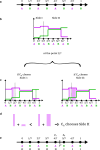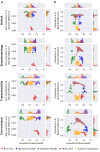Balancing the benefits of vaccination: An envy-free strategy
- PMID: 38463036
- PMCID: PMC10923509
- DOI: 10.1093/pnasnexus/pgae087
Balancing the benefits of vaccination: An envy-free strategy
Abstract
The Covid-19 pandemic revealed the difficulties of vaccinating a population under the circumstances marked by urgency and limited availability of doses while balancing benefits associated with distinct guidelines satisfying specific ethical criteria. We offer a vaccination strategy that may be useful in this regard. It relies on the mathematical concept of envy-freeness. We consider finding balance by allocating the resource among individuals that seem heterogeneous concerning the direct and indirect benefits of vaccination, depending on age. The proposed strategy adapts a constructive approach in the literature based on Sperner's Lemma to point out an approximate division of doses guaranteeing that both benefits are optimized each time a batch becomes available. Applications using data about population age distributions from diverse countries suggest that, among other features, this strategy maintains the desired balance, throughout the entire vaccination period. We discuss complementary aspects of the method in the context of epidemiological models of age-stratified Susceptible - Infected - Recovered (SIR) type.
Keywords: balanced vaccine allocation; decision making process; direct and indirect benefits; envy-free division; pandemic preparedness.
© The Author(s) 2024. Published by Oxford University Press on behalf of National Academy of Sciences.
Figures









Similar articles
-
Vaccination of children with a live-attenuated, intranasal influenza vaccine - analysis and evaluation through a Health Technology Assessment.GMS Health Technol Assess. 2014 Oct 30;10:Doc03. doi: 10.3205/hta000119. eCollection 2014. GMS Health Technol Assess. 2014. PMID: 25371764 Free PMC article.
-
Optimizing two-dose vaccine resource allocation to combat a pandemic in the context of limited supply: The case of COVID-19.Front Public Health. 2023 Apr 24;11:1129183. doi: 10.3389/fpubh.2023.1129183. eCollection 2023. Front Public Health. 2023. PMID: 37168073 Free PMC article.
-
Risk management frameworks for human health and environmental risks.J Toxicol Environ Health B Crit Rev. 2003 Nov-Dec;6(6):569-720. doi: 10.1080/10937400390208608. J Toxicol Environ Health B Crit Rev. 2003. PMID: 14698953 Review.
-
Vaccinating Children against COVID-19: Commentary and Mathematical Modeling.mBio. 2022 Feb 22;13(1):e0378921. doi: 10.1128/mbio.03789-21. Epub 2022 Jan 18. mBio. 2022. PMID: 35040706 Free PMC article.
-
Pharmacoeconomics of influenza vaccination for healthy working adults: reviewing the available evidence.Drugs. 2002;62(7):1013-24. doi: 10.2165/00003495-200262070-00003. Drugs. 2002. PMID: 11985488 Review.
References
-
- World Health Organization . 2020. A global framework to ensure equitable and fair allocation of covid-19 products and potential implications for covid-19 vaccines. Technical Report, World Health Organization.
LinkOut - more resources
Full Text Sources

